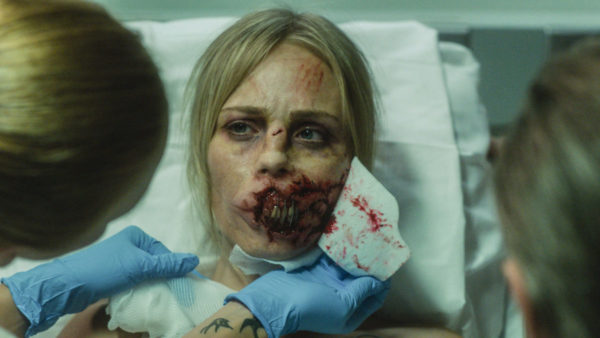
In He Said/She Said, critics Joe and Valeska dissect a film in a back and forth email exchange. Previously, we tackled Susanne Bier’s Netflix “horror for the masses” film, Bird Box (2018). This time, we’re staying Canadian with the Soska Sisters’ reimagining of David Cronenberg‘s 1977 film, Rabid (2019).
Spoilers ahead…
Synopsis: “After a young woman, Rose (Laura Vandervoort), suffers a disfiguring accident, she undergoes an experimental stem-cell treatment that leads to unintended consequences.
HE SAID
Oh hai. It appears that we now only manage to get approximately one of these off the ground per year, so I’m very excited to come back together to discuss Rabid.
Oh wait…no, I’m just excited to come back together because WTF did we just watch? And not WTF in a good way.
So Cronenberg’s original 1977 Rabid is a slice of Canadian genre nostalgia. It’s a relic of a bygone era when Cronenberg was still the “enfant terrible” of the Hollywood North scene. Exhibit A: the lead actress of his second major feature film is none other than world-renowned sex worker Marilyn Chambers, who at this time was right in middle of her two most famous pornographic films – Behind The Green Door (1972) and Insatiable (1980). Obviously, this is Cronenberg in full “shit disturber” mode, as he’s out there courting controversy in the wake of the events of Shivers (1975), which caused a national sensation.
Now, I haven’t seen the original Rabid, but I know enough about it to spot the very deliberate, albeit occasionally ill-advised, homages that Jen and Sylvia Soska have made to the source material, as well as Cronenberg’s other films. In some ways, these linkages back to the original and its ilk are the most fascinating components in a very messy film, which struggles with pacing, tone, and a narrative that confusingly attempts to conflate the creative process of a mad scientist with that of a fashion designer, while also updating the political messaging for a modern audience.
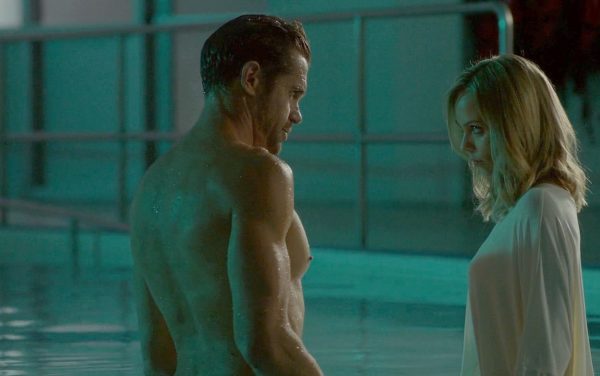
The result is, unfortunately, a bit of a disaster. Rabid is a property that seems ripe for a modern, feminist take by directors who hold the original in high esteem, but the Soskas simply don’t have a good handle on what they want Rabid to say or be about. While the original adheres to the same overall plot structure – woman injured in a motorcycle accident undergoes experimental stem cell procedure that turns her into a predator whose victims become carriers of a zombie-like virus – the new film makes a few creatively destructive decisions that the finished film simply can’t overcome.
Chief among them is the decision to frame Rose’s attacks as possible hallucinations for the first half of the film. Not only do we, as an audience, learn very quickly that her “lucid dreams” are, in fact, a reality, but by keeping Rose in the dark about what is happening to her own body, Rabid makes her out to be a frustratingly dumb protagonist. Up until the film’s closing scenes, Rose is locked out of this narrative, which only serves to render the infection scenes when her victims spread the disease on film sets, in coffee shops and hospital wards, all the more pointless.
There is no mystery here: Rose is blissfully unaware of events outside of her immediate experience and these scenes rarely feature characters we know or are invested in. They’re also quite long; considering how familiar and relatively straightforward Rose’s urges are to anyone even remotely aware of horror films, these scenes come across like gore for gore’s sake. They also pad the runtime, which is wholly unnecessary in a 1 hr 50 minute film with so little to say.
And that’s my real issue with Rabid: what is this film trying to say or do? Initially, it feels like the Soska Sisters are taking a (very obvious) bite out of sexism and shallowness in the fashion industry. But that message only really resonates when piggish Gunter (Mackenzie Gray) is onscreen, otherwise it’s nearly forgotten. There’s also clearly something to gleaned from the act of creation, in the way that Ted Atherton’s villainous Dr. William Burroughs (UGH) is positioned as a “creator” in the same way Rose herself becomes as a designer following the procedure. And yet, this all feels shallow and skin deep (heh heh).
Perhaps I’ll pass the baton over to you, Valeska. What do you take the film’s meaning to be? Does the “rabies” infection plot (an awkward holdover from the original) work for you? Did you appreciate that at least Rose’s model friend Chelsea (Hanneke Talbot) didn’t become her adversary?
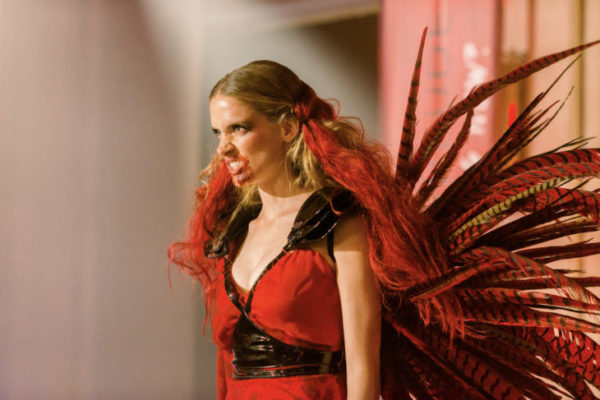
SHE SAID
Well, I’ll focus on the positive stuff first: the styling in this film is fabulous. While a lot of the fashion didn’t quite work for me, most of it did (my god, Rose’s dress in the clubbing scene is #goals), and the hair and makeup artists more than earned their paycheques. I appreciated the effort to pull the narrative in a more feminist direction and the inclusion of the fashion plot was an interesting choice, at least on paper. And I adored Hanneke Talbot’s performance as Chelsea, who was, by far, my favourite character.
Second of all, wait – you haven’t seen the original Rabid?? You’re supposed to be my Cronenberg friend! How have you not seen it?! I’ve never been more disappointed in you, and you made me watch McG’s The Babysitter.
In terms of the film’s meaning…well, as you say, it all feels very surface-level. There is a lot of ambition, and a lot of weighty ideas, but the end result is heavy on style and relatively light on substance. I’d been excited to see this remake since it was first announced, and the first still photos released increased that excitement (as we’ve discussed, the makeup in this film is top-notch, and that goes double for the SFX). And while I enjoyed the visual aspects of the film, the narrative felt scattered and a little unfocused. To be honest, I don’t have an answer for you – I’m not really sure what my overall takeaway is, message-wise. Neither of the possibilities you mentioned are explored deeply enough to give the film a vigorous through-line. For a film about semi-cannibalism, there isn’t a lot of real meat.
As for the viral storyline? I mean, it’s fine. It’s right in the title, so I don’t think it could have been dropped without jettisoning the entire remake angle. Did we have to have the phallic armpit stinger? Definitely not, but I can see the sentimental value of retaining it as a tribute to Cronenberg’s original vision and the symbolic value of using it to make a psychoanalytical argument regarding gendered aggression.
Also, I hate to be that nerd, but the incubation period of the virus seemed to vary wildly – one character seemed to manage a week or so before succumbing to the disease, while another reached his end-stage less than five minutes after being attacked. Granted, there are a number of different factors that affect pathogenesis, and I’m definitely being a bit nitpicky about a fictional disease, but the looseness of the narrative exacerbated the biological inconsistencies for me – since I had difficulty finding footing in the story emotionally, I became distracted by its science.

It’s a shame, because I did enjoy a lot of Laura Vandervoort’s performance in this film. She brought a nice balance of vulnerability and assertiveness, and I appreciated her rare ability to keep the focus on her acting even while wearing that incredible, eye-catching SFX makeup. She did a great job.
And yes, I loved that Chelsea was (and remained) a supportive and loving friend to Rose. That is one narrative piece that I think the film got exactly right. Far too many stories lean on the idea of the ubiquitousness of female competition and hostility, which has never rung true to me. It’s a sad state of affairs when the portrayal of a sincere female friendship feels like a triumph of filmmaking, but here we are. I genuinely adored the relationship between Chelsea and Rose – it felt very real and lovingly executed. I’d love it if that sort of depiction were the norm.
You didn’t love the story, but what did you think about the fashion, Joe? I know that there weren’t any bell-bottoms, but did you love any of the flashy suits on that runway? How would you have tweaked the story to strengthen its message – and what message would you have liked to have seen the film tackle? And, most importantly, can we get matching red sleeveless jumpsuits for the Grim anniversary weekend in February?
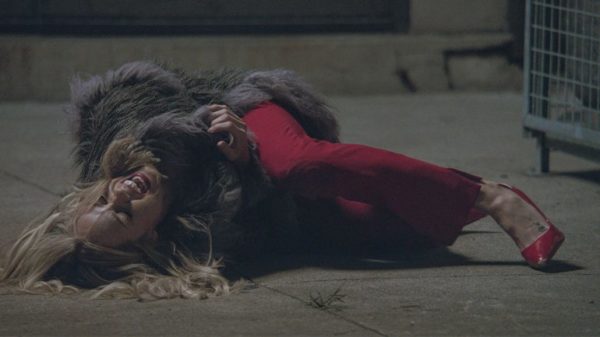
HE SAID
I’m glad that you enjoyed the fashion; I did, as well. Aside from the (frankly ridiculous) scene when Rose impulsively demonstrates how adept a designer she is by hacking away at Chelsea’s dress in front of the entire office to turn it into a masterpiece, I thought that the fashion was bright and striking. I particularly liked the visual symmetry between Burrough’s red operating clothes (a Cronenberg homage to Dead Ringers, naturally) and Rose’s collected works later in the film.
It should also be noted that Rose seemingly draws influence from the Soska sister’s in-film bitchy characters, who are both wearing high-fashion red outfits at the bar when they’re talking shit about her. Is it a bit of a simple metaphor to have Rose express her evil (black) cannibal (red) impulses via her preferred art? Sure…but it still works.
Since we’ve circled back to the Soskas and we’re both interested in feminist/queer/racialized critiques in film, we should address the elephant in the room. This remake of Rabid stirred the controversy pot earlier this year when a gruesome still from the film (which was widely published on the internet, including a Rue Morgue cover and a feature on Fangoria) got the Soskas banned from Twitter. It garnered a lot of attention because it highlighted a fairly obvious issue with the social media platform’s algorithm, prompting some to speculate on a gendered or genre attack.
Despite numerous attempts to reactivate their account, the Soskas were offline for a lengthy period of time and were only able to return when their cause was championed by Jack Posobiec, a supporter of far-right causes (he’s responsible for digging up information on Pizzagate and getting James Gunn fired) whom the twins repeatedly and publicly thanked under the guise of “free speech” and tackling “censorship.” The politics of aligning with an incredibly damaging public figure can’t help but influence the reception of Rabid; the film is literally all about men exerting toxic masculinity and privilege over women’s bodies and careers, but publicly it has benefited from the attention of political figures who condone the same treatment.
Controversy aside, Valeska, what do you think of the film’s feminism, particularly the tricky character of Brad (Benjamin Hollingsworth) who is both a spy and also a love interest? Did you enjoy the ridiculously Canadian cast overall? And, finally, what’s your overall score for Rabid (2019)?
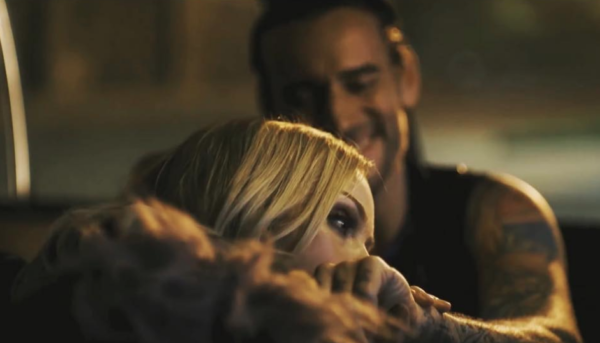
SHE SAID
I notice that you did not respond to my query about the red jumpsuits and I can only interpret that as wholehearted agreement. Send me your measurements when we’re done this review.
Ah, the elephant. You’re right – it’s difficult to approach this film without considering it in light of the recent controversies, and I don’t think we should try to. The entire thing was (and is) so disheartening, especially as we have relatively few high-profile female genre filmmakers (or female filmmakers in general) to serve as inspirations and to serve up representative media.
The Soskas have become known for, I would argue, specifically feminist stances and cinematic endeavours – look at 2012’s excellent American Mary or their powerful ‘T is for Torture Porn’ instalment in The ABCs of Death 2 of the same year. I want to be transparent here: I’ve admired their devotion to this style of storytelling, as I admired (and still do) their outspoken stance against abuses in the industry, particularly their dedication to spotlighting child sexual abuse. I’ve promoted their work in the past and even interviewed them for Grim. As I said above, I was legitimately excited to hear that they held the reins of this remake and looked forward to their female-focused take on the story.
Then, the Twitter-ban happened.
So…the events of the last few months have been rough. I initially sympathized with the Soskas’ frustration regarding the Twitter situation, which was completely unfair and, yes, quite possibly the result of a gendered attack targeting two relatively high-profile and outspoken female genre creators – something that the twins have dealt with before. But sitting down with Jack Posobiec, who has described extraordinarily punchable white supremacist goon Richard Spencer as “indispensable” and regularly promotes anti-Semitism? As a fan and a feminist film critic (and one enamoured with genre films in particular), their association with a dangerous alt-right figure known for inflammatory conspiracy theories and tweeting about the 14 words both pains and disturbs me.
The sisters have argued that they are apolitical and that the association is based on a shared dedication to free speech, but engaging with a known neo-Nazi (and defending that engagement when their audience expressed their dismay) feels both tone-deaf and unfathomable to me on a personal and political level. I have Jewish friends whom I absolutely adore and I cannot stomach racism at any level, so the ‘free speech’ argument is just…I can’t. I can’t imagine aligning myself with a white supremacist or backing anyone who chooses to. Even outside of this hellish and hate-ridden powder keg of a political climate, Posobiec’s views have no place in society, period. Even if those views are plagiarized from other hatemongers. It’s not enough to merely ban him from Bumble. The paradox of tolerance plays a critical role in any discussion regarding free speech, a principle that I think is amply illustrated by the current sociopolitical state of affairs.
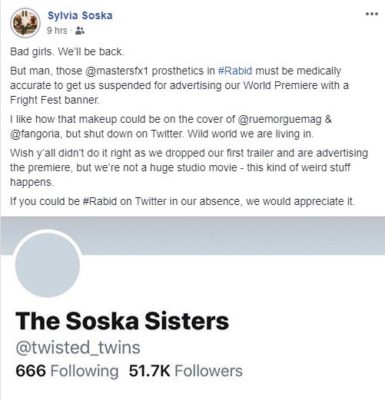
So…yeah. The months since the Soskas’ Twittergate moment have been a bit of a complicated mourning period for me.
Sorry, what was the question? Ah, yes. The Brad character. I thought his dual motivations were an interesting choice, and I believed in both his professional ambitions and the chemistry between Hollingsworth and Vandervoort. His duplicity, while perhaps well-meaning overall, did add an interesting wrinkle to the plot, but I don’t really understand why Dr. Burroughs would trust him with the information about Rose’s condition – clearly, he knew about Brad’s desire to become a journalist (referenced during the climax), which makes the disclosure even more baffling. Why risk having his secret medical experiments and their potential consequences become public record? What could Burroughs have to gain from this? I enjoyed Brad as a character, as well as his push/pull dynamic with Rose, but this element of the plot was a stretch.
Regarding the Canadian-ness of the cast, I think it is well-established that my love for maple syrup horror is matched only by yours (and Paul Corupe’s), so I don’t think I need to answer that.
My overall score for the film is probably 4.5 or maybe 5/10, as I did enjoy the way that it looked and the feminist update to the subject matter. There is a cat-calling scene at the midpoint that is particularly effective in realistically demonstrating the perils of living while female, particularly as a WOC. I really hope that we continue to see a rise in female genre creators who are able to capture particularly gendered nuances and tell these types of stories. We are in dire need of more inspirational figures, the more diverse the better.
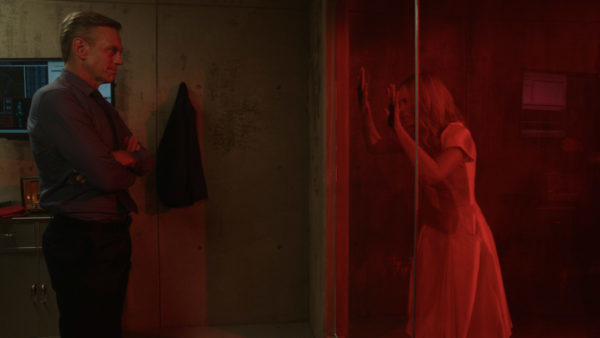
HE SAID
I agree. Perhaps in the future we can hope that the Twisted Twins will realize how detrimental their association with Posobiec is and publicly denounce him, but for now, it’s nearly impossible to be on their side since they are on the wrong side of history. As a film, Rabid complements the Soska sisters’ prior themes, but for my money, it pales in comparison to a film like American Mary, which tackles many of the same themes and preoccupations, but does so in a more satisfying and less convoluted fashion. Alas this is messy and unformed; Rabid really needed another few drafts at the script level to strengthen its overall vision. I give it a 4/10.
—Rabid (2019) is out Dec 13 in select theatres
Other He Said/She Said entries: